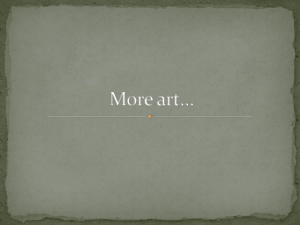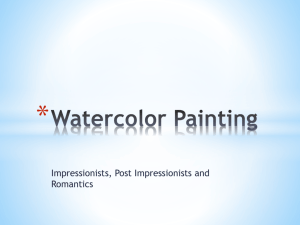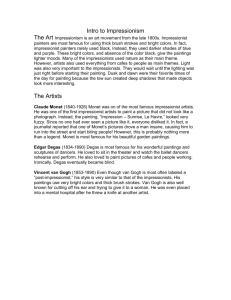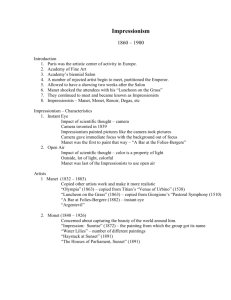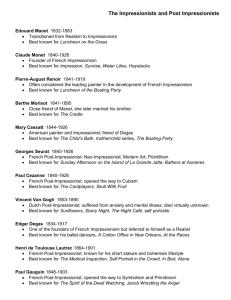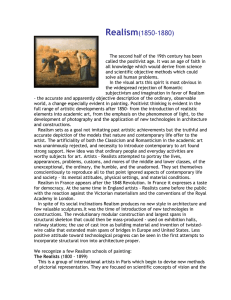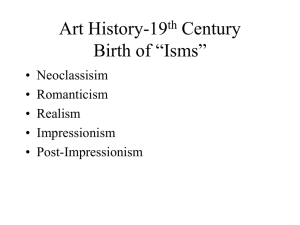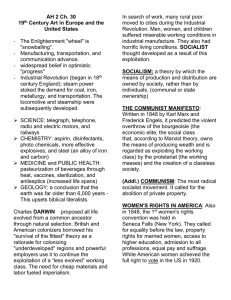Chapter 19 -- Realism, Impressionism, Post-Impressionism century?
advertisement
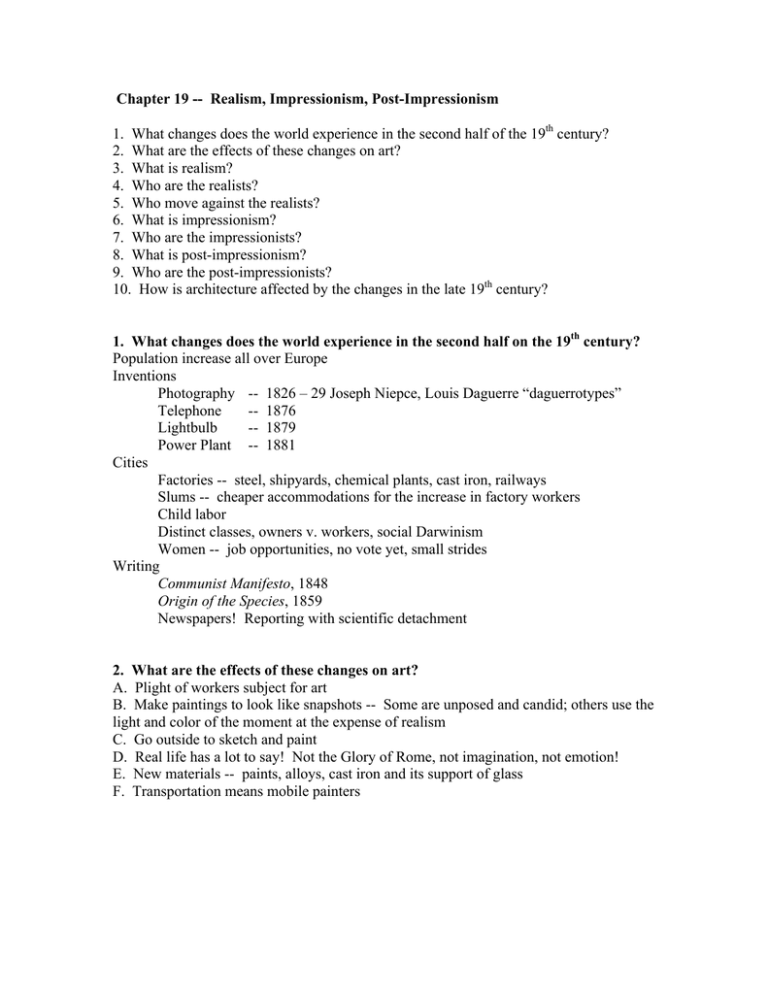
Chapter 19 -- Realism, Impressionism, Post-Impressionism 1. What changes does the world experience in the second half of the 19th century? 2. What are the effects of these changes on art? 3. What is realism? 4. Who are the realists? 5. Who move against the realists? 6. What is impressionism? 7. Who are the impressionists? 8. What is post-impressionism? 9. Who are the post-impressionists? 10. How is architecture affected by the changes in the late 19th century? 1. What changes does the world experience in the second half on the 19th century? Population increase all over Europe Inventions Photography -- 1826 – 29 Joseph Niepce, Louis Daguerre “daguerrotypes” Telephone -- 1876 Lightbulb -- 1879 Power Plant -- 1881 Cities Factories -- steel, shipyards, chemical plants, cast iron, railways Slums -- cheaper accommodations for the increase in factory workers Child labor Distinct classes, owners v. workers, social Darwinism Women -- job opportunities, no vote yet, small strides Writing Communist Manifesto, 1848 Origin of the Species, 1859 Newspapers! Reporting with scientific detachment 2. What are the effects of these changes on art? A. Plight of workers subject for art B. Make paintings to look like snapshots -- Some are unposed and candid; others use the light and color of the moment at the expense of realism C. Go outside to sketch and paint D. Real life has a lot to say! Not the Glory of Rome, not imagination, not emotion! E. New materials -- paints, alloys, cast iron and its support of glass F. Transportation means mobile painters 3. What is realism? Rejects the Romantic idea Does not glorify the past! Does not celebrate nature! Attempts to portray without being sentimental or idealistic “It’s real, yo.” -- Rachel Perzchowski 4. Who are the realists? A. Gustave Courbet Burial at Ornans Nonconformist Submits many paintings between 1841 and 1847 Establishes his reputation Ornans was mocked, thought a joke, shows his grandfather’s funeral B. Thomas Eakins The Gross Clinic First American Realist Central HS, PAFA, Jefferson Medical College Teaches at PAFA, fired over “scandal” Used photography extensively Excelled in sport art, medical art, portraiture The Agnew Clinic C. Edouard Manet Olympia Émile Zola “Father of modern art” Olympia shows high-class prostitute, her glance is shocking! (compare with Ingres) Candid pose for Zola D. Edgar Degas Cotton Exchange Academically trained, aristocratic by birth More famous for his impressionist works Blind at 60ish Why is this a great realistic painting? 5. Who move against the realists? 1848, PRB is formed -- Pre-Raphaelite Brotherhood 3 young rebels: Dante Gabriel Rossetti, John Everett Millais, William Holman Hunt Goal: turn back to art before Raphael; felt English art had become formulaic and “history and scenery” Their art: colorful, precise, storytelling: myth, Shakespeare, poetry, legend, Bible A. John Everett Millais The Carpenter’s Shop Christ as a child; meaningful, realistic, colorful, symbolic 6. What is Impressionism? Realism plus! Effects of light on subjects Photographic and momentary “sight more than insight” no story less rigid, blurred edges, lacks focal points color used in place of black, brown, grey textured surface (impasto) and short brushstrokes 7. Who are the Impressionists? A. Claude Monet Japanese Bridge at Giverny Exhibition of 1874 Impression: Sunrise created the unkind moniker Fascinated by how sunlight changes the color of things – haystack series, poplar series, Rouen Cathedral series B. Auguste Renoir Le Moulin de la Galette Happy! People, friends, lovers! Never painted night or winter “There is enough ugliness in the world without having it in my pictures” C. Georges Seurat Sunday Afternoon on the Island of La Grande Jette Impressionism plus (or minus?) Optical painting/ Pointillism Less random; he believes it shows the effects of light better Sunday shows clean landscape, happy color, happy setting, happy people? Isolated? D. Mary Cassatt Boating Party Privileged youth in Pitt PAFA trained Paris and Degas Mother and child themes Blind in her 60s (like her mentor) New role: US collection of the Impressionists E. Edgar Degas Glass of Absinthe Interested in the figure in motion (dancers) Realist turned impressionist Unbalanced scenes Recluse at end of life Sculptures cast after his death Glass shows us table with no legs! Unsympathetic man and woman; alienation in Paris nightlife F. Edouard Manet Rue Mosnier Bar at Follies Bergere Realist turned Impressionist Rue shows us a photograph? We see that in Bar, we are the customer; shows alienation in nightlife G. Berthe Morisot Great-granddaughter of Fragonard Married Eugene Manet Able to be an artist due to immense wealth H. Henry Tanner Philadelphia, under Eakins 32 to Paris Within 5 years, a Salon favorite I. James Abbott MacNeil Whistler American expatriate Pals with Oscar Wilde Painted Thames & city & night & water; influenced by Asian art 8. What is Post-Impressionism? Less about light; still keep the color and energy of the impressionists Wanted to “discover what is missing” in impressionism: Which is: composition, form, structure 9. Who are the Post-Impressionists? A. Paul Cezanne Mont Ste. Victoire Basket of Apples Joins impressionists Concerned with solidity, structure, stability Concerned with color theory: warm v. cool Mont is painted over 60 times Basket: color theory B. Vincent Van Gogh Starry Night Bumpy early life -- art, business, ministry At 33 goes to Paris -- meets impressionists At 35 moves to Arles in Provence for the last two years of his life. Arles work is fab but he’s clearly unstable! Sells 1? Painting in his lifetime High auction prices! Characterized by twisted line and color use C. Paul Gaughin Day of the God Prosperous stockbroker, amateur painter 35 to the South of France, 42 - 55 in Tahiti known for decorative pattern, exotic style, shape and color Deep stories in many of his works D. Henri Toulouse-Lautrec At the Moulin Rouge Black sheep Painted Paris nightlife Revolutionized poster painting Theme of isolation Self-portrait in the Moulin Rouge 10. How is architecture affected by these changes? Architects look to the use and function of the building to determine its design Total freedom of choice in architectural style, eclectic buildings New materials = new possibilities Eiffel Tower Liberty Enlightening the World
